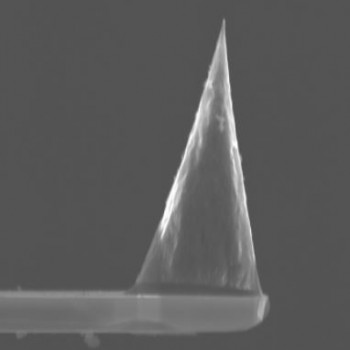
Full Diamond (FD) cantilevers HA_HR/FD consist of standard polysilicon chips and consoles and high quality single crystal diamond needle grown in CVD process and fixed on a lever. Manufacturing a diamond tip with tip's curvature radius less than 12nm and attaching this tip to our own-made polysilicon lever, together with our partners we're glad to present on the market the very special offer: the highest quality AFM tips for routine measurements for the reasonable prices! Our new probes are remarkable for the next features:
 Full diamond tip is harder than a standard silicone one. Its wear is about 10 times lower and it allows to measure surfaces that grind fast silicon needles. More of all, such cantilevers will be the best for measurements of surface elasticity properties. Their deformation during force curves processing will be minimal respectively to other-material tips;
Full diamond tip is harder than a standard silicone one. Its wear is about 10 times lower and it allows to measure surfaces that grind fast silicon needles. More of all, such cantilevers will be the best for measurements of surface elasticity properties. Their deformation during force curves processing will be minimal respectively to other-material tips;Great utility of FD AFM cantilevers for precise measurements is accompanied by a detailed quality control. After gluing a tip to a lever each cantilever is being observed by SEM before shipment. Thus only good probes reach the customers.
|
Applications: Scanning sticky biological samples |
 |
Our colleague from University of Nebraska Medical Center, Mohtadin Hashemi, have reported about outstanding FD probes utility for measurements of sticky biological samples. He tried both FD and Si probes for scanning of fibril and globular amyloid aggregates. When standard Si tip could be used only for 2-3 hours (then its surface became too dirty, catching sample's material), FD cantilever didn't show any degradation during 7 hours continous repeated scan of the same area. Images from the both sides were taken with 3 hours difference - no tip's or sample's degradation can be noticed. |  |
|
Applications: Less sensitivity to surface charges |
 |
Our experiment have showed that FD cantilevers are less sensitive to effect of image distortion due to surface charges. To the left you may find an image of silver nanoparticles on mica by a standard Si cantilever in low humidity conditions. It took around 1 hour of parameters' adjustment to get this image. The engineer had to decrease contact amplitude of cantilever's oscillation 10 times in respect to free oscillations. To the right you may find a scan of the same surface, obtained by FD probe without any special adjustments. Image is more sharp and particles' sizes are much lower, as they should be in accordance to non-AFM investigation of this sample. |  |
|
Cantilever specification |
Chip thickness H: 0,4mm.
Reflective side coating: Au.
Tip's cone angle: < 25 degrees.
Tip's aspect ratio: > 1:5.
Tip's curvature radius: < 12 nm.
Chip has one rectangular spring.
| Cantilever type | A | Typical dispersion |
| Length, L (µm) | 93 | ± 2 |
| Width, W (µm) | 34 | ± 3 |
| Thickness, H (µm) | 3 | ± 0.15 |
| Force Constant (N/m) | 34 | ±20% |
| Resonant frequency (kHz) | 380 | ± 10% |
***HA_HR/FD probe could be produced with another type of HA_HR lever (230 kHz resonance frequency) by request.